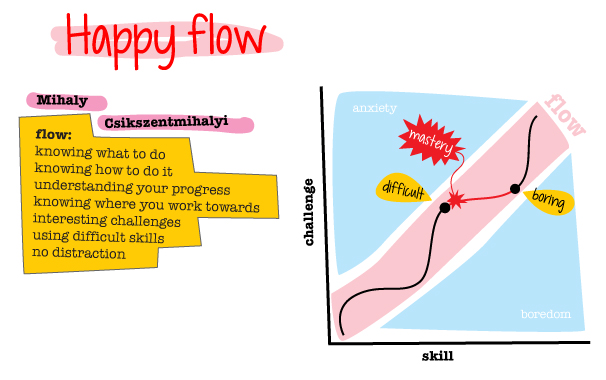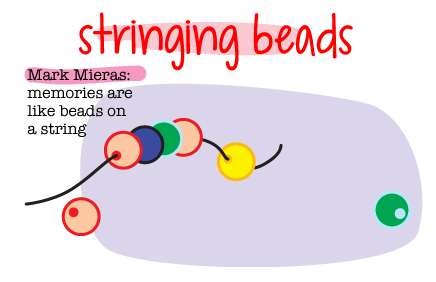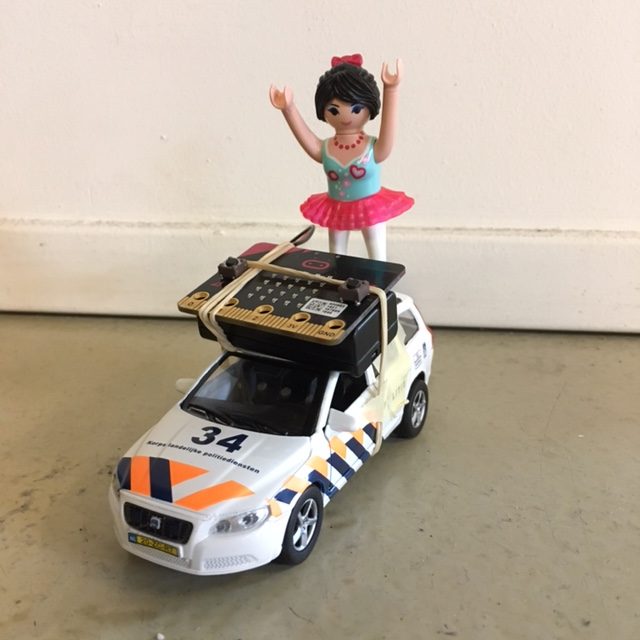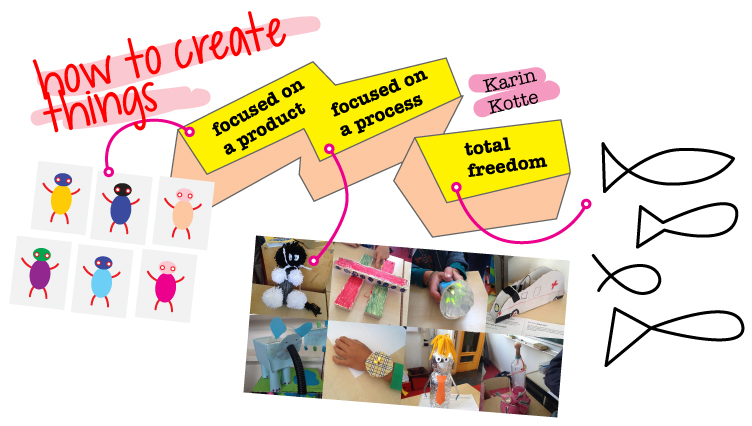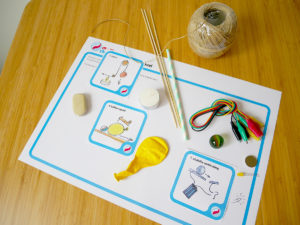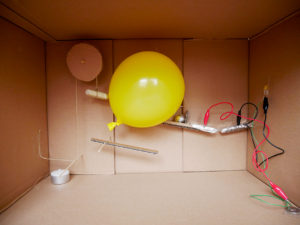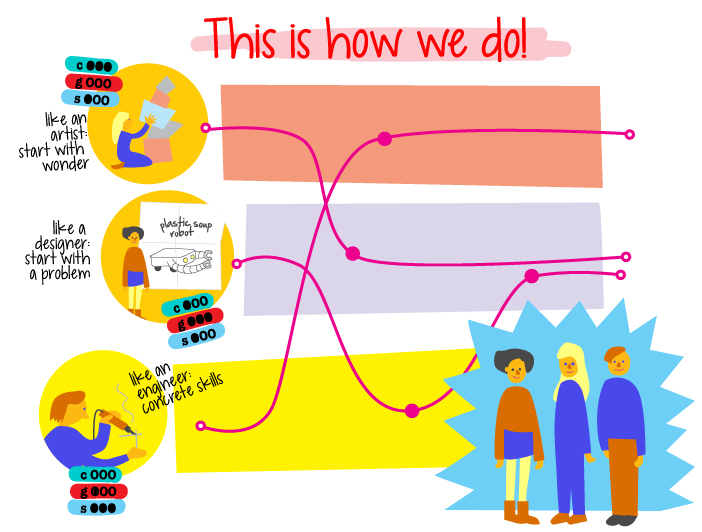I was invited to do a keynote and training on making and creativity for librarians. You know, the people who know it all! I was not sure what I had to offer so I decided to connect things I refer to in my thinking about makered into this illegible messy overview:
Conditions for Learning and How It Is All Connected.
I heard my messy overview is a nice conversation starter. So get your colleagues, get coffee, and discuss!
Start in the centre: conditions for learning.
- Learners need knowledge: without prior knowledge, learners have no clue how to relate to the new materials or topics that are offered. They cannot ask questions, because they don’t know what they should be about. (And stating ‘I don’t get it at all!’ often does not inspire the support needed.)
- Learners need trust; to feel confident (because of the knowledge or experience you have) and to be trusted by someone else: to know the teacher of guide believes the learner can do it, and to know he or she will help when necessary.
- Gusto! The learner is into it. He likes the topics, he likes the place and the people and feels noticed.
When these conditions are met, the learning can start. A lot has to do with flow: happy learning and working. Mihaly Csikszentmihalyi knows all about that:
Doing great!
The Hungarian psychologist Csikszentmihalyi showed that learning works best when the learner is in a state of flow. Flow being completely focused motivation.
Activities that cause flow, are intrinsically motivating.
You want to do it. Because you are good at it and want to improve your skills. In flow there is a perfect balance between what you can do (skills) and what is expected from you (challenge).
it sticks when it connects
Knowledge has to to with experience and memories. But new experiences don’t always make memories. Dutch physicist, brain researcher and author Mark Mieras explains how that works:
New experiences are like beads. When there is no existing string of beads where they fit, they roll away. So: when you encounter something new, you can only keep it when it matches existing memories in some way. Too new and it won’t stick.
Memories are like beads on a string.
Always connect to an existing memory before offering new things.
It starts with a memory
To induce a high quality creative product, it is good to activate existing memories in the maker. Kickstarting imagination and creation is easier after that. And finally, reflecting on the work creates new memories.
In the Digi-klooikoffer with the micro:bit we start every lesson with real world examples, so (also the self-proclaimed non digital) children can connect more easily. ‘Crashing a car? I now that!’ Making a crash-test with a micro:bit follows smoothly after that.
What is a nice (good?) assignment?
There are roughly three ways to approach an assignment.
- Focused on the product: clear instructions: make exactly this! (We tend to be a bit judgemental about these sort of assignments, but they can provide safety in getting to know a new concept or material.)
- Focused on the process: ask questions and provide sub-assignments to help learners get to their own creative product.
- Total freedom: give an open assignment like: make a fish. It sounds simple and easy, but because of the lack of structure it is really very difficult. Fear of the empty canvas causes learner to put their very first idea on paper. Not very creative, not very safe.
The process approach causes most development in the learner. It meets the flow-standards best.
In our maakchalllenge (makerchallenge) (a chain-reaction assignment) we seem to have succeeded in designing a nice process. We get all sorts of great maker-stories. (In Dutch but wit loads of images: the Friezen and the Groningers.)
The determing factor in all these three approaches is off course the teacher.
When you have been teaching for a long time, you tend to make your work more interesting.
That’s only natural. you want to experience flow too. What can happen, is that what you designed to be a process approach, feels more like a total freedom approach tot your learners. To hard, too open. The teacher adjusted the level of the assignment to his own interest and has accidentally made it too difficult to his learners.
This is the curse of knowledge. A bit like Pedro de Bruyckere says in his Klaskit: As an experienced teacher, you build expertise. Your expertise grows, while your (new) students are the same every year. The gap widens.
pick your own (starting) strategy
We are all different. And (fixed) learning styles do not exist. That’s evident. But there are different strategies in making and creativity. And they are connected to the amount of experience and knowledge you have and how confident you feel.
Depending on situation and topic learners choose a starting strategy. And once they started, learners can switch strategies without effort. They feel confident and are self-steering. These are not fixed patterns, but have to do with someone’s background.
The free-creative kids we all know, are usually just more experienced. That experience sets them free.
They come from a maker-household or have been taken to musea often. The kids who don’t like the emphasis on creativity (the engineer in this model), often prefer the product approach. The creative freedom follows after.
It is all about creating the right conditions
- A good workplace (atmosphere and room)
- Good stuff (tools and materials)
- Enough time (probably the biggest challenge)
- A good start (think of the three strategies and how you can accommodate them all)
- Being trusted en feeling confident
- Attentive attention (be the teacher and guide, not the photographer and/or social media reporter)
Yeah whatever, what does this do for me?
The feedback I got so far is that this messy overview helps evaluate your lessons and assignments. When it didn’t work, what went wrong? And when it worked really well, why was it so successful? It may help you see. (And some people just hate it. I get that.)
Good luck. <3
This is blog 4 in a series of 5 stories about about thinking:
- The balance between thinking and making
- About boredom and action
- Failing is no fun at all
- Why you need knowledge, skills and that other thing
- What I can teach you (spoiler: nothing)

